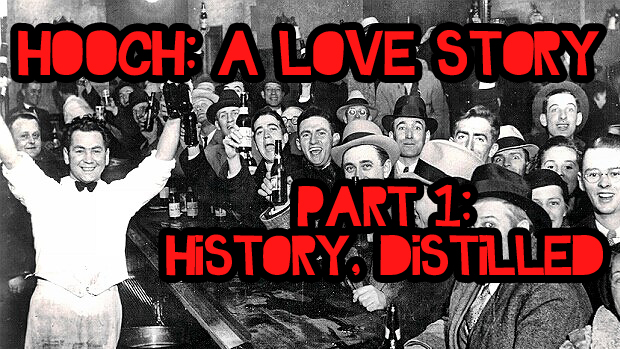
 Depending on the source, alcohol can either be described as the worst of all evils or one of humanity’s most enjoyable discoveries. I can see truth on both sides of the issue. Though, as a bartender by trade, I am inclined to be biased towards the latter. No matter the opinion, it is certainly one of the oldest stumbled-upon inventions.
Depending on the source, alcohol can either be described as the worst of all evils or one of humanity’s most enjoyable discoveries. I can see truth on both sides of the issue. Though, as a bartender by trade, I am inclined to be biased towards the latter. No matter the opinion, it is certainly one of the oldest stumbled-upon inventions.
The history of alcoholic beverages is a hotly debated subject, but there are a few key points that most historians can agree on. There is some evidence to suggest that China was the first producer of an alcoholic beverage (a kind of mead/wine hybrid), and different cultures have produced alcohol in various forms over time, but I will be focusing on the timeline that has been the most influential in the adoption of alcohol by modern people. The grape was first domesticated and grown in what is now Lebanon around 9000 BC. At some point, a Neolithic Lebanese tribesman (or tribeswoman) probably forgot about some grapes he had left in an urn out in the sun, only to come back and find some very powerful fumes meeting his nose as the sugars in those old grapes began to ferment in the heat. I am sure this first “experiment” was not very tasty, but the end effect would still be inebriation—something that I am afraid many of us are familiar with. Over the next few millennia this process was refined, grapes began to be transported and grown in other parts of the known world, and, by 4000 BC, the Phoenicians had a bustling wine trade across the Mediterranean. Heck, the Greeks and Romans even began worshipping a god of wine in their respective pantheons at some point.
 By the 8th century, the Arab world had started its Golden Age. They were the leaders in the fields of chemistry (alchemy), math (algebra), and were the first people to create a still (alembic). By using this newly invented still, Jabir ibn Hayyar, the Arabic scientist known as the father of chemistry, was able to take the fermentation process a step further. After a substance had been fermented, it could then be heated up, and the alcoholic vapor that escaped the mixture could be siphoned off and concentrated into a spirit. In fact, one of the theories explaining the origin of the word, “alcohol,” comes from the Arabic word, “al ghoul,” or “the spirit.” Though, most people believe it is actually derived from, “al kohool,” which is Arabic for “eyeliner,” and in which alcohol can still be a key ingredient. In general, if a word starts with “al,” it is likely that it has an Arabian origin.
By the 8th century, the Arab world had started its Golden Age. They were the leaders in the fields of chemistry (alchemy), math (algebra), and were the first people to create a still (alembic). By using this newly invented still, Jabir ibn Hayyar, the Arabic scientist known as the father of chemistry, was able to take the fermentation process a step further. After a substance had been fermented, it could then be heated up, and the alcoholic vapor that escaped the mixture could be siphoned off and concentrated into a spirit. In fact, one of the theories explaining the origin of the word, “alcohol,” comes from the Arabic word, “al ghoul,” or “the spirit.” Though, most people believe it is actually derived from, “al kohool,” which is Arabic for “eyeliner,” and in which alcohol can still be a key ingredient. In general, if a word starts with “al,” it is likely that it has an Arabian origin.
Though the distillation process was discovered in 8th century Iraq, it was not until the technology reached Europe in the 12th century that it began to be perfected. The Salerno School of Italy were the first to distill a spirit that could safely be imbibed, and, after the information spread to nearby countries, liquors unique to specific regions began to emerge. By the 15th century the first incarnations of gin, vodka, brandy, whisky, schnapps, and others had appeared.
 Though booze can get a bad rap these days, its true purpose for thousands of years was much more innocent. Until Agostino Bassi discovered the existence of microorganisms in the early 1800s, and Louis Pasteur discovered that high temperatures killed those harmful microorganisms in the 1860s, no one understood why drinking water could make them sick. Indeed, the pilgrims only landed at Plymouth Rock because they were running low on beer. They needed to establish a base and start a brewery before their supply ran out because, while they knew that they could safely drink ale (beer fermented at high temperatures), water could be deadly. They did not realize that in the process of making their beer they were pasteurizing it at the same time; they only understood that beer was safe and water was not. Also, wine has not always been worshipped because of its ability to keep a party going; without knowing why it had antiseptic properties, ancient cultures understood that they could pour wine into their water to make it safe to drink.
Though booze can get a bad rap these days, its true purpose for thousands of years was much more innocent. Until Agostino Bassi discovered the existence of microorganisms in the early 1800s, and Louis Pasteur discovered that high temperatures killed those harmful microorganisms in the 1860s, no one understood why drinking water could make them sick. Indeed, the pilgrims only landed at Plymouth Rock because they were running low on beer. They needed to establish a base and start a brewery before their supply ran out because, while they knew that they could safely drink ale (beer fermented at high temperatures), water could be deadly. They did not realize that in the process of making their beer they were pasteurizing it at the same time; they only understood that beer was safe and water was not. Also, wine has not always been worshipped because of its ability to keep a party going; without knowing why it had antiseptic properties, ancient cultures understood that they could pour wine into their water to make it safe to drink.
So now that the history lesson is over, the biggest thing to understand when it comes to the delights and dangers of hooch is this: all things in moderation. With that being said I present, as a parting gift, a wonderfully light cocktail to help take the bite out of these last few summer heat waves. The shandy is a cocktail that can mean something completely different depending on where it is ordered, but in the US, and specifically the South, it is simply a mixture of lemonade and beer at a ratio of 1:1. If that does not sound strong enough, it is perfectly acceptable to add an ounce or two of bourbon to the mix. Regardless, it should be served in a tall glass over ice and sipped on a front porch without shoes, or maybe in the grove—shoes still optional. ![]()
–
This article was originally printed in The Local Voice #212 (published September 11, 2014).
To download the PDF of this issue, click here.


